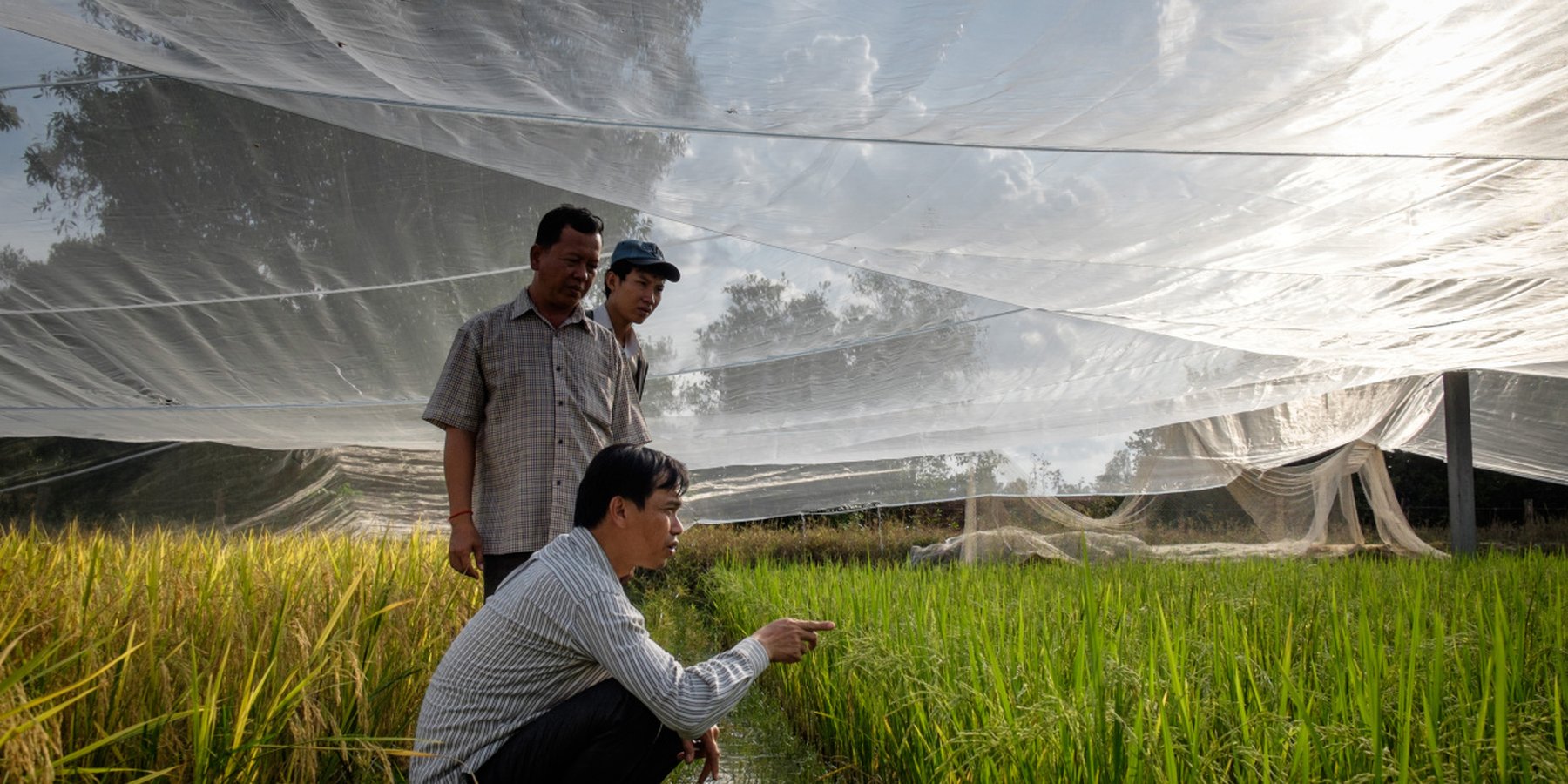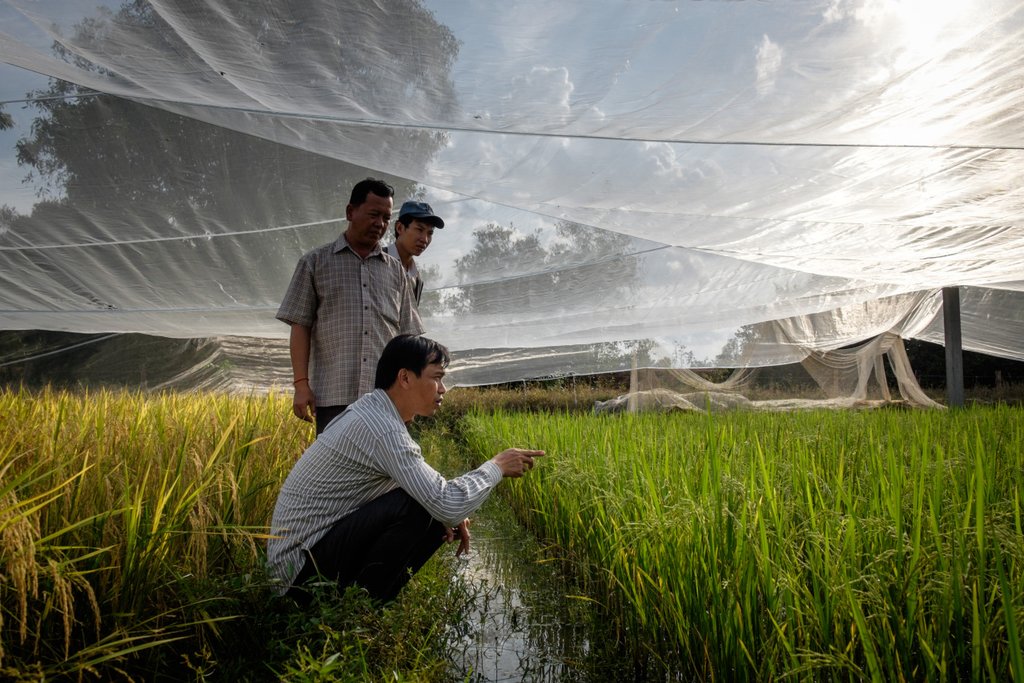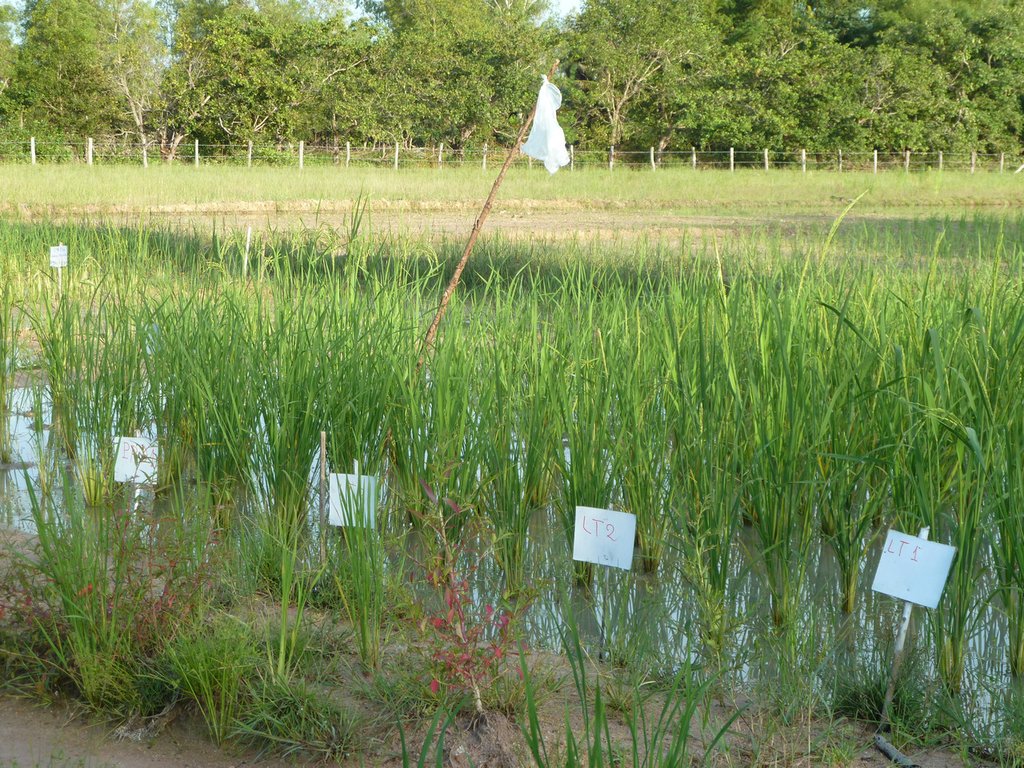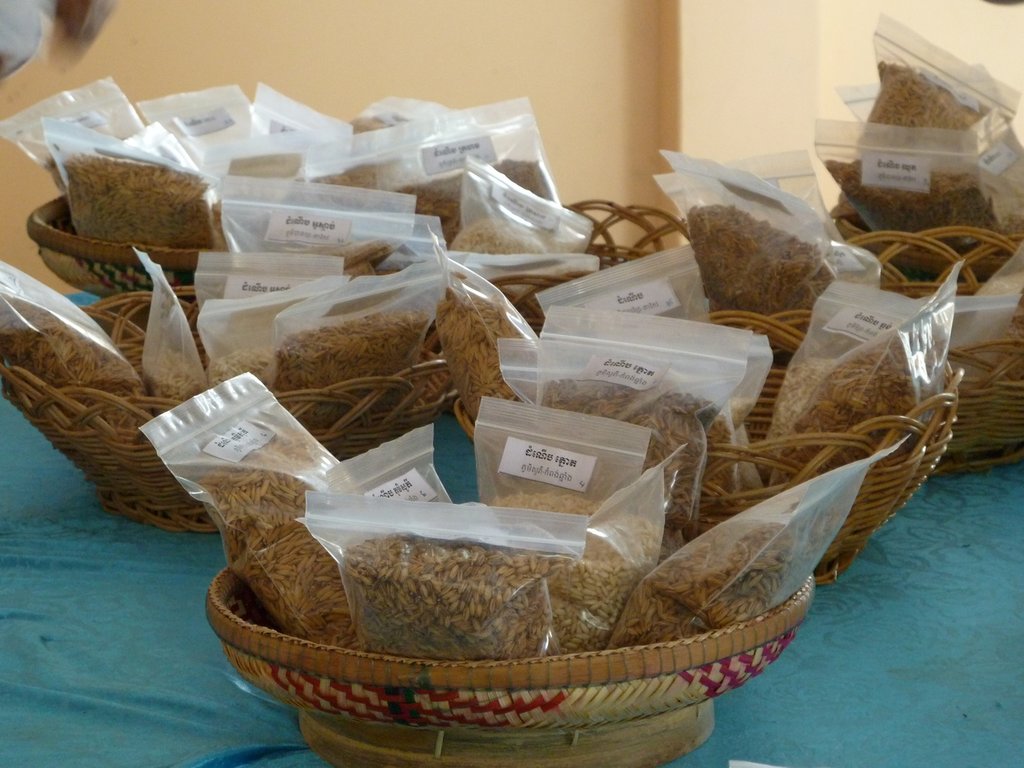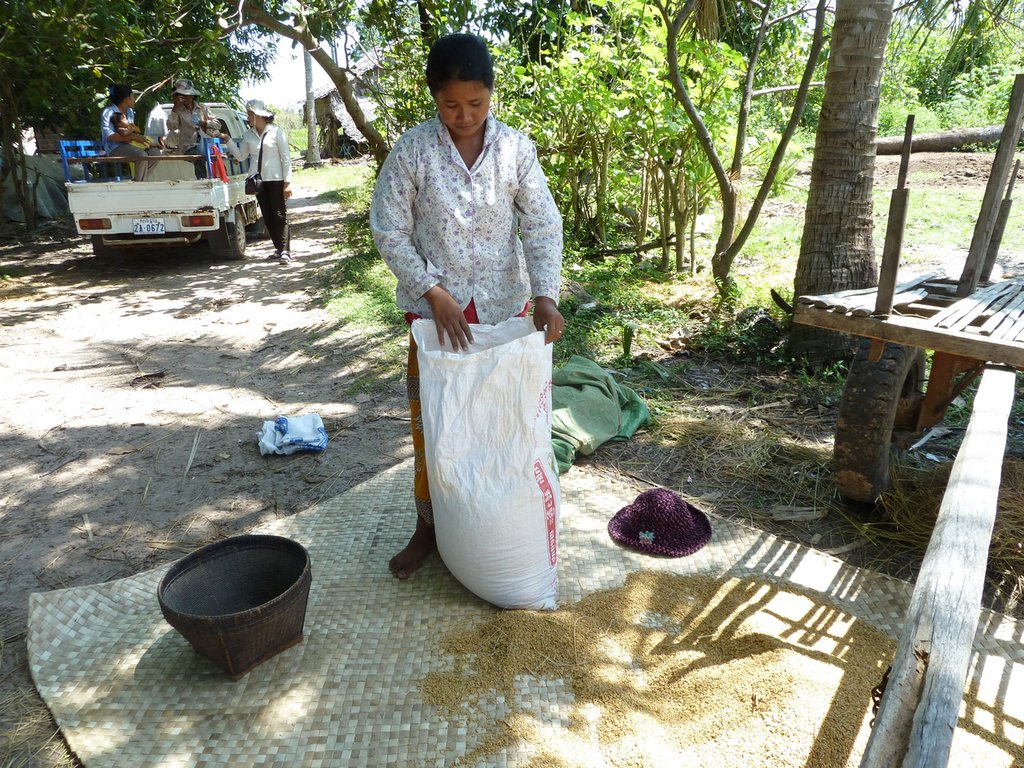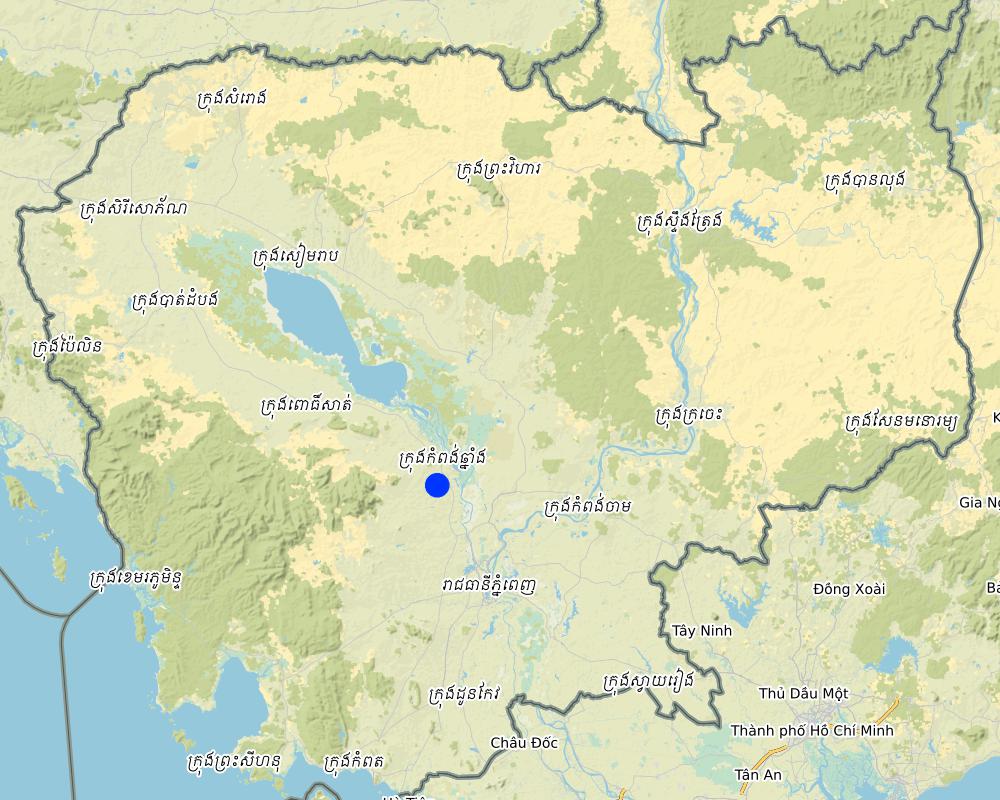Collection, selection, breeding and dissemination of locally adapted rice varieties at the Local Agricultural Research and Extension Centre LAREC. [Cambodia]
- Creación:
- Actualización:
- Compilador: Stefan Graf
- Editores: Christine Lottje, Christoph Kaufmann, Stefan Graf, Judith Macchi
- Revisores: Judith Macchi, Alexandra Gavilano, Boris Orlowsky
approaches_1880 - Cambodia
- Resumen completo en PDF
- Resumen completo en PDF para imprimir
- Resumen completo en el navegador
- Resumen completo (sin formato)
- Collection, selection, breeding and dissemination of locally adapted rice varieties at the Local Agricultural Research and Extension Centre LAREC.: 29 de agosto de 2017 (inactive)
- Collection, selection, breeding and dissemination of locally adapted rice varieties at the Local Agricultural Research and Extension Centre LAREC.: 12 de marzo de 2021 (inactive)
- Collection, selection, breeding and dissemination of locally adapted rice varieties at the Local Agricultural Research and Extension Centre LAREC.: 12 de marzo de 2021 (public)
Visualizar secciones
Expandir todo Colapsar todos1. Información general
1.2 Detalles de contacto de las personas de referencia e instituciones involucradas en la evaluación y la documentación del Enfoque
Persona(s) de referencia clave/s
Especialista MST:
Khun Lean Hak
kleanghak@yahoo.com / sofdec@camintel.com
SOFDEC/LAREC
www.sofdec.com
Cambodia
Especialista MST:
Pith Khonhel
012 585892
khonhel@gmail.com
LAREC Local Agricultural Research and Extension Centre
www.sofdec.org
Cambodia
1.3 Condiciones referidas al uso de datos documentados mediante WOCAT
¿Cuándo se compilaron los datos (en el campo)?
01/08/2014
El compilador y la/s persona(s) de referencia claves aceptan las condiciones acerca del uso de los datos documentados mediante WOCAT :
Sí
2. Descripción del Enfoque MST
2.1 Breve descripción del Enfoque
Local genetic rice varieties which are better adapted to changing climatic conditions are collected on farms, tested, described, selected or bred into new varieties and again distributed to farmers with the goal to increase their food security
2.2 Descripción detallada del Enfoque MST
Descripción detallada del Enfoque MST:
Farmers in the central Cambodian province of Kampong Chhnang increasingly struggle with changing and unpredictable weather patterns and regular weather extremes. Lately, water supply has fluctuated annually due to alternating drought and flood extremes. Harvest yields from farmers in the region are low, amongst others, due to the use of low-quality seed, which is not adapted to local conditions, and which demands for an increase in the use of chemical fertilizers and pesticides.
Acknowledging the fact that with changing climatic conditions, local genetic resources and genetic diversity play a vital role to guarantee food security of smallholder farmers, the Local Agricultural Research and Extension Center – LAREC collects, selects, tests, breeds and disseminates rice varieties, which are better adapted to local conditions. To answer to the climate extremes of drought and flood, LAREC focusses its research on flood tolerant and drought resistant rice varieties.
Over the past years 36 flood tolerant rice varieties have been investigated by LAREC research staff for their floating ability and submergence tolerance. 6 varieties among these are: Pork Kraham, Chung Banla-6, STR010, STR10, STR 011 and Chung Banla-2, have been defined as the most appropriated varieties in term of stem elongation, submergence tolerance and yield. These are multiplied and recommended for farmers in flood prone areas.
Regarding drought tolerance LAREC bred a new variety derived from a cross between Phka Rumduol and IRRI breeding line. This variety is tested in an on farm adaptive trial to see crop performance under farmer practice. The two lines have a short growth duration range from 75 days to 90 days and are non-photo period sensitive. Besides the short growth duration, which makes them appropriate for drought prone areas, the new variety also has a desirable aroma which is important for acceptance and marketing purposes. However, to provide scientific evidence, thorough testing in on-farm trials is needed to see yield performance under farmers’ condition, seed rate application based on cultivation method and fertilizer application.
After the production of basic seed for rice LAREC distributes the seed to contract farmers for multiplication under the supervision of LAREC staff. The multiplied seed is distributed to interested buyers through LAREC and the local farmers' associations.
2.3 Fotos del Enfoque
2.5 País/ región/ lugares donde el Enfoque fue aplicado
País:
Cambodia
Región/ Estado/ Provincia:
Kampong Chhnang
Especifique más el lugar :
Rolea Pha-ear
Comentarios:
Area where the seeds are used is 10-100 km2
Map
×2.6 Fechas de inicio y conclusión del Enfoque
Indique año del inicio:
2010
2.7 Tipo de Enfoque
- proyecto/ basado en un programa
2.8 Propósitos/ objetivos principales del Enfoque
Provide high quality seeds of local varieties which are better adapted to changing climatic conditions to the farmers in the area.
2.9 Condiciones que facilitan o impiden la implementación de la/s Tecnología/s aplicadas bajo el Enfoque
normas y valores sociales/ culturales/ religiosos
- facilitan
The founding of LAREC as a local research station was needs-based, as a consequence of increasing exposure of farmer's rice yields to extreme weather events (drought and flood)
- impiden
Farmers are consulted in the selection of seed varieties, but not engaged in the research process.
There is a certain degree of aversion towards local varieties by the farmers, due to lower yields.
disponibilidad/ acceso a recursos y servicios financieros
- facilitan
The building up of LAREC (warehouse, office building, greenhouse, drying site, trial field) was rendered possible due to funding by SOFDEC/HEKS
conocimiento de MST, acceso a apoyo técnico
- facilitan
Highly specialized research personnel working with local varieties adapted to local conditions
- impiden
Only limited knowledge transfer to farmers, as research is conducted in the center, not through a participatory breeding approach
mercados (para comprar insumos, vender productos) y precios
- impiden
LAREC struggels to become self-sustained by selling the seeds on the local market.
3. Participación y roles de las partes interesadas involucradas
3.1 Partes interesadas involucradas en el Enfoque y sus roles
- usuarios locales de tierras/ comunidades locales
Farmers
Farmers are involved in the selection of seeds and some contracted farmers act as seed multipliers for LAREC
- organizaciones comunitarias
Community committees
They play a role to facilitate and promote the seed produced by LAREC. They also support the selection of seeds and follow up on the contracting farmers
- investigadores
LAREC reserach personnel
Selection, testing, breeding of adapted varieties
- ONG
SOFDEC
HEKS (Swiss Church Aid)
SOFDEC provided 100% of the funding. SOFDEC staff links LAREC to the farmers and support the collection, dissemination promotion of the seeds and are also collecting feedback from farmers for discussion with LAREC team to find the solution.
HEKS (Swiss Church Aid) is the main backdonor of SOFDEC and hence of LAREC.
- gobierno nacional (planificadores, autoridades)
Cambodian Agricultural Research and Development Institute (CARDI)
CARDI plays an advisory role and also supports the promotion of LAREC.
LAREC is linked to CARDI to exchange on seed multiplication
3.2 Involucramiento de los usuarios locales de tierras/ comunidades locales en las distintas fases del Enfoque
| Involucramiento de los usuarios locales de tierras/ comunidades locales | Especifique quién se involucró y describa las actividades | |
|---|---|---|
| iniciación/ motivación | pasivo | LAREC was initiated by SOFDEC, as a consequence of an increasing exposure of farmer's rice yields to weather extremes (drought/flood) |
| planificación | ninguno | Planning of the center by SOFDEC |
| implementación | pasivo | LAREC collects seed varieties on farms, tests, selects, breeds and disseminates seed again to farmers. Farmers do the multiplication of seeds and use the adapted varieties for their rice production (own consumption and for the market) |
| monitoreo y evaluación | ninguno | M+E is conducted by LAREC, SOFDEC and HEKS ((internally) as well as by external evaluators (at the end of each project phase) |
| Research | pasivo | Selection of promising varieties is done in consultation with the farmers. Research with the selected crops is done entirely on the LAREC site. |
3.3 Flujograma (si estuviera disponible)
3.4 La toma de decisiones en la selección de Tecnología(s) MST
Especifique quién decidió la selección de las Tecnología/ Tecnologías a implementarse:
- principalmente por especialistas MST en consulta con usuarios de tierras
Explique:
The selection of the breeding lines is conducted with farmers. Research and testing of the selected varieties is done entirely on the LAREC site, without farmers involvement.
LAREC decides on how and where the adapted varieties were distributed.
Especifique las bases que sustentaron la toma de decisiones:
- hallazgos de investigaciones
- la experiencia personal y opiniones (no documentadas)
4. Apoyo técnico, fortalecimiento institucional y gestión del conocimiento
4.1 Construcción de capacidades / capacitación
¿Se proporcionó la capacitación a usuarios de tierras/ otras partes interesadas?
Sí
Especifique quién fue capacitado:
- usuarios de tierras
Forma de capacitación:
- cursos
Temas avanzados:
Contract farmers are trained on seed production and seed storage.
4.2 Servicio de asesoría
¿Los usuarios de tierras tienen acceso a un servicio de asesoría?
No
4.3 Fortalecimiento institucional (desarrollo institucional)
¿Se establecieron o fortalecieron instituciones mediante el Enfoque?
- sí, mucho
Especifique el nivel o los niveles en los que se fortalecieron o establecieron las instituciones:
- local
Describa la institución, roles y responsabilidades, miembros, etc.
Establishment of a local agricultural research center
Especifique el tipo de apoyo:
- financiero
- construcción de capacidades/ entrenamiento
- equipo
4.4 Monitoreo y evaluación
¿El monitoreo y la evaluación forman parte del Enfoque?
Sí
Comentarios:
Yearly monitoring of number of land users using selected of new varieties. Ad-hoc measurements of yield (carried out by project staff)
Si respondió que sí, ¿la documentación se utilizará para monitoreo y evaluación?
Sí
Comentarios:
The documentation of yield and land users involved is used for measuring outputs and outcomes of the project based on the indicators set in proposal. This is also used for routine monitoring by project staff as well as for mid-term and end project-phase evaluations.
4.5 Investigación
¿La investigación formó parte del Enfoque?
Sí
Especifique los temas:
- tecnología
Proporcione detalles adicionales e indique quién hizo la investigación:
Research to select and improve local rice varieties to be better adapted to changing climatic conditions is the main activity of the approach.
5. Financiamiento y apoyo material externo
5.1 Presupuesto anual para el componente MST del Enfoque
Si no se conoce el presupuesto anual preciso, indique el rango:
- 10,000-100,000
5.2 Apoyo financiero/material proporcionado a los usuarios de tierras
¿Los usuarios de tierras recibieron financiamiento/ apoyo material para implementar la Tecnología/ Tecnologías? :
No
5.3 Subsidios para insumos específicos (incluyendo mano de obra)
- equipo
| Especifique qué insumos se subsidiaron | En qué grado | Especifique los subsidios |
|---|---|---|
| maquinaria | totalmente financiado | |
| herramientas | totalmente financiado | |
- construcción
| Especifique qué insumos se subsidiaron | En qué grado | Especifique los subsidios |
|---|---|---|
| piedra | totalmente financiado | |
Si la mano de obra de usuarios de tierras fue un insumo sustancial, ¿fue:
- voluntario?
5.4 Crédito
¿Se proporcionó crédito bajo el Enfoque para actividades MST?
No
5.5 Otros incentivos o instrumentos
¿Se usaron otros incentivos o instrumentos para promover la implementación de Tecnologías MST?
No
6. Análisis de impacto y comentarios de conclusión
6.1 Impactos del Enfoque
¿El Enfoque ayudó a los usuarios de tierras a implementar y mantener Tecnologías MST?
- No
- Sí, un poco
- Sí, moderadamente
- Sí, mucho
Farmers have access to seed varieties which are adapted to local conditions (e.g. drought and flood resistance), ensuring that yields are also generated in case of an extreme weather event.
¿El Enfoque resultó en mejor seguridad alimentaria/ mejoró la nutrición?
- No
- Sí, un poco
- Sí, moderadamente
- Sí, mucho
Through the use of seed varieties which are adapted to local conditions, (e.g. drought and flood resistance) farmers increase their food security by ensuring that yields are also generated in case of an extreme weather event. Farmers are more resilient against extreme weather events.
¿El Enfoque mejoró la capacidad de los usuarios de tierras a adaptarse a los cambios climáticos/ extemos y mitigar desastres relacionados al clima?
- No
- Sí, un poco
- Sí, moderadamente
- Sí, mucho
Through the use of seed varieties which are adapted to local conditions, (e.g. drought and flood resistance) farmers increase their food security by ensuring that yields are also generated in case of an extreme weather event. Farmers are more resilient against extreme weather events.
¿El Enfoque llevó a oportunidades de empleo, ingresos?
- No
- Sí, un poco
- Sí, moderadamente
- Sí, mucho
Additional income for contract farmers through seed multiplication
6.2 Motivación principal del usuario de la tierra para implementar MST
- reducción del riesgo de desastres naturales
Adapted varieties also perform in the case of an extreme weather event (drought/flood)
6.3 Sostenibilidad de las actividades del Enfoque
¿Pueden los usuarios de tierras sostener lo que se implementó mediante el Enfoque (sin apoyo externo)?
- incierto
Si respondió no o incierto, especifique y comente:
If the seeds are not promoted through a project (e.g. by SOFDEC), it is up to the farmers to buy the adapted varieties.
6.4 Fortalezas/ ventajas del Enfoque
| Fuerzas/ ventajas/ oportunidades desde la perspectiva del usuario de la tierra |
|---|
| Seeds of high quality are provided by LAREC. |
| Quality of crops from LAREC-seed is uniform and varieties are demanded on the market, thus contributing to an increasing farmer income. |
| Increased food-security as adapted seeds also perform in the likelihood of an extreme weather event. |
| Fuerzas/ ventajas/ oportunidades desde la perspectiva del compilador o de otra persona de referencia clave |
|---|
| Seeds are collected in the region from the farmers, thus adapted to the local conditions. (They are collected in the research center and in addition the center buys foundation seeds from the Cambodian Agricultural Research and Development Institute (CARDI) in order to scale up). |
6.5 Debilidades/ desventajas del Enfoque y formas de sobreponerse a ellos
| Debilidades/ desventajas/ riesgos desde la perspectiva del compilador o de otra persona de referencia clave | ¿Cómo sobreponerse a ellas? |
|---|---|
| Farmers are still dependent on getting new seeds of the selected varieties (every 3 years for rice) as seeds get mixed and cross pollination occurs. | |
| Lack of money to store the seeds in a proper way. Lack of material (silica gel, oven). | Find external financing sources. Connect with international seed saving organisations if collection and distribution of local ecotypes gets a higher priority. |
| Breeding and selection is not happening on-farm, only at the LAREC centre. Land users remain highly dependent on LAREC to provide new seeds every few years. | Implement participatory plant breeding. Train farmers in selection (already happening with mung bean and rice) and breeding. |
7. Referencias y vínculos
7.1 Métodos/ fuentes de información
- visitas de campo, encuestas de campo
- entrevistas con usuarios de tierras
- compilación de informes y otra documentación existente
7.2 Referencias a publicaciones disponibles
Título, autor, año, ISBN:
Paris, T., et al. 2011. Guide to participatory varietal selection for submergence-tolerant rice. IRRI
¿Dónde se halla disponible? ¿Costo?
www.irri.org
7.3 Vínculos a la información relevante disponible en línea
Título/ descripción:
The Society for Community Development in Cambodia (SOFDEC) is a Cambodian Non-Governmental Organization, established in 2006 through the localization of HEKS (the Swiss Church Aid) project in Kampong Chhnang province, Cambodia. The vision of SOFDEC is that Cambodian people living in Cambodia live a state of comfort, equality, equity, and have ownership over the sustainable development of their community. The mission of SOFDEC works in partnership with community based organizations and relevant institutions through integrated community development, research, human resource development, enhancement of family economies, in the hopes to uplift the living standards of the people in the target areas. Our goal aims to uplift the living standards of the rural people of Cambodia through the improvement in income generation, sustainable agricultural practices, microfinance, health, human resource development, and sustainable natural resource management.
URL:
www.sofdec.com
Vínculos y módulos
Expandir todo Colapsar todosVínculos
No hay vínculos
Módulos
No se hallaron módulos


